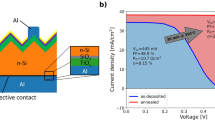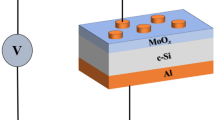Abstract
MoOX (X < 3) has shown its promising potential as an efficient hole-selective passivating contact in crystalline Si solar cells. The device performance highly depends on the film properties of MoOX film, which is significantly affected by different synthesis methods. In this work, Si solar cells with c-Si(p)/MoOX rear contacts were demonstrated, where the MoOX films were realized by thermal evaporation (TE), atomic layer deposition (ALD), and UV-assisted ALD (UV-ALD) methods. A pronounced efficiency drop was disclosed with the order of TE, ALD, and UV-ALD MoOX. Subsequently, the contact propertieis, crystallinity, chemical states, roughness, density, and refractive indices of MoOX films were systematically characterized by a series of microscopic and spectroscopic analyses. It is found that the TE film is composed of nanocrystals, while ALD methods yield amorphous feature with a smaller density and refractive indices. A mild UV illumination (3.5 mW/cm2) slightly reduces the film roughness, while a stronger (35 mW/cm2) one increases the film density, roughness, and growth rate significantly.






Similar content being viewed by others
Data availability
The authors declare that materials described in the paper, including all relevant raw data, will be freely available to any scientist wishing to use them for non-commercial purposes, without breaching participant confidentiality.
References
C. Battaglia, S.M. de Nicolas, S. De Wolf et al., Silicon heterojunction solar cell with passivated hole selective MoOx contact. Appl. Phys. Lett. 104, 113902 (2014)
J. Bullock, A. Cuevas, T. Allen, C. Battaglia, Molybdenum oxide MoOx: a versatile hole contact for silicon solar cells. Appl. Phys. Lett. 105, 232109 (2014)
J. Dreon, Q. Jeangros, J. Cattin et al., 23.5%-efficient silicon heterojunction silicon solar cell using molybdenum oxide as hole-selective contact. Nano Energy 70, 104495 (2020)
E.M. Sanehira, B.J.T. de Villers, P. Schulz et al., Influence of electrode interfaces on the stability of perovskite solar cells: reduced degradation using MoOx/Al for hole collection. ACS Energy Lett. 1, 38–45 (2016)
X.G. Yu, T.J. Marks, A. Facchetti, Metal oxides for optoelectronic applications. Nat. Mater. 15, 383–396 (2016)
Y.L. Zou, R.J. Holmes, Influence of a MoOx interlayer on the open-circuit voltage in organic photovoltaic cells. Appl. Phys. Lett. 103, 138 (2013)
C. Battaglia, X. Yin, M. Zheng et al., Hole selective MoOx contact for silicon solar cells. Nano Lett. 14, 967–971 (2014)
J. Melskens, B.W. van de Loo, B. Macco, L.E. Black, S. Smit, W. Kessels, Passivating contacts for crystalline silicon solar cells: from concepts and materials to prospects. IEEE J. Photovolt. 8, 373–388 (2018)
S. Cao, J. Li, J. Zhang et al., Stable MoOX-based heterocontacts for p-type crystalline silicon solar cells achieving 20% efficiency. Adv. Funct. Mater. 30, 2004367 (2020)
S.Y. Cao, J.Y. Li, Y.Y. Lin et al., Interfacial behavior and stability analysis of p-type crystalline silicon solar cells based on hole-selective MoOX/metal contacts. Solar RRL. 3, 1900274 (2019)
S. Ashraf, C.S. Blackman, G. Hyett, I.P. Parkin, Aerosol assisted chemical vapour deposition of MoO(3) and MoO(2) thin films on glass from molybdenum polyoxometallate precursors; thermophoresis and gas phase nanoparticle formation. J. Mater. Chem. 16, 3575–3582 (2006)
V. Nirupama, M.C. Sekhar, T.K. Subramanyam, S. Uthanna, Structural and electrical characterization of magnetron sputtered MoO3 thin films. J. Phys. Conf. Ser. 208, 012101 (2010)
S.S. Sunu, E. Prabhu, V. Jayaraman, K.I. Gnanasekar, T. Gnanasekaran, Gas sensing properties of PLD made MoO3 films. Sens. Actuators B-Chem. 94, 189–196 (2003)
M. Diskus, O. Nilsen, H. Fjellvag, Growth of thin films of molybdenum oxide by atomic layer deposition. J. Mater. Chem. 21, 705–710 (2011)
K. Inzani, T. Grande, F. Vullum-Bruer, S.M. Selbach, A van der Waals density functional study of MoO3 and its oxygen vacancies. J. Phys. Chem. C. 120, 8959–8968 (2016)
K. Khojier, H. Savaloni, S. Zolghadr, On the dependence of structural and sensing properties of sputtered MoO3 thin films on argon gas flow. Appl. Surf. Sci. 320, 315–321 (2014)
E. McCarron III., J. Calabrese, The growth and single crystal structure of a high pressure phase of molybdenum trioxide: MoO3-II. J. Solid State Chem. 91, 121–125 (1991)
D.O. Scanlon, G.W. Watson, D.J. Payne, G.R. Atkinson, R.G. Egdell, D.S.L. Law, Theoretical and experimental study of the electronic structures of MoO3 and MoO2. J. Phys. Chem. C. 114, 4636–4645 (2010)
V. Cremers, R.L. Puurunen, J. Dendooven, Conformality in atomic layer deposition: current status overview of analysis and modelling. Appl. Phys. Rev. 6, 021302 (2019)
B. Hoex, J. Schmidt, P. Pohl, M.C.M. van de Sanden, W.M.M. Kessels, Silicon surface passivation by atomic layer deposited Al2O3. J. Appl. Phys. 104, 044903 (2008)
P. Poodt, A. Lankhorst, F. Roozeboom, K. Spee, D. Maas, A. Vermeer, High-speed spatial atomic-layer deposition of aluminum oxide layers for solar cell passivation. Adv. Mater. 22, 3564–3567 (2010)
B. O'donnell, The weekend read: atomic layer deposition storms market for PERC. https://www.pv-magazine.com/2019/06/29/the-weekend-read-atomic-layer-deposition-storms-market-for-perc/ (2019)
X. Yang, K. Weber, Z. Hameiri, S. De Wolf, Industrially feasible, dopant-free, carrier-selective contacts for high-efficiency silicon solar cells. Prog. Photovolt. 25, 896–904 (2017)
H. Kim, Characteristics and applications of plasma enhanced-atomic layer deposition. Thin Solid Films 519, 6639–6644 (2011)
C. Detavernier, J. Dendooven, D. Deduytsche, J. Musschoot, Thermal versus plasma-enhanced ALD: growth kinetics and conformality. ECS Trans. 16, 239–246 (2008)
K.-M. Kim, J.S. Jang, S.-G. Yoon, J.-Y. Yun, N.-K. Chung, Structural, optical and electrical properties of HfO2 thin films deposited at low-temperature using plasma-enhanced atomic layer deposition. Materials 13, 2008 (2020)
X.B. Yang, E. Aydin, H. Xu et al., Tantalum nitride electron-selective contact for crystalline silicon solar cells. Adv. Energy Mater. 8, 1800608 (2018)
P.O. Oviroh, R. Akbarzadeh, D.Q. Pan, R.A.M. Coetzee, T.C. Jen, New development of atomic layer deposition: processes, methods and applications. Sci. Technol. Adv. Mater. 20, 465–496 (2019)
J. Ziegler, M. Mews, K. Kaufmann et al., Plasma-enhanced atomic-layer-deposited MoO(x) emitters for silicon heterojunction solar cells. Appl. Phys. A-Mater. 120, 811–816 (2015)
P.R. Chalker, Photochemical atomic layer deposition and etching. Surf. Coat. Technol. 291, 258–263 (2016)
K.J. Yuan, R.N. Dixon, X.M. Yang, Photochemistry of the water molecule: adiabatic versus nonadiabatic dynamics. Acc. Chem. Res. 44, 369–378 (2011)
T. Iimori, K. Hattori, K. Shudo, T. Iwaki, M. Ueta, F. Komori, Laser-induced mono-atomic-layer etching on Cl-adsorbed Si(111) surfaces. Appl. Surf. Sci. 130, 90–95 (1998)
B.H. Lee, S. Cho, J.K. Hwang, S.H. Kim, M.M. Sung, UV-enhanced atomic layer deposition of ZrO2 thin films at room temperature. Thin Solid Films 518, 6432–6436 (2010)
S.K. Kim, S. Hoffmann-Eifert, R. Waser, High growth rate in atomic layer deposition of TiO2 thin films by UV irradiation. Electrochem. Solid State 14, H146 (2011)
K.H. Yoon, H. Kim, Y.-E.K. Lee, N.K. Shrestha, M.M. Sung, UV-enhanced atomic layer deposition of Al2O3 thin films at low temperature for gas-diffusion barriers. RSV Adv. 7, 5601–5609 (2017)
W. Kern, Handbook of Semiconductor Wafer Cleaning Technology (Noyes Publication, New Jersey, 1993), pp. 111–196
T. Zhang, C.Y. Lee, Y.M. Wan, S. Lim, B. Hoex, Investigation of the thermal stability of MoOx as hole-selective contacts for Si solar cells. J. Appl. Phys. 124, 073106 (2018)
H.C. Card, Aluminum—Silicon Schottky barriers and ohmic contacts in integrated circuits. IEEE Trans. Electr. Devices. 23, 538–544 (1976)
R. Cox, H. Strack, Ohmic contacts for GaAs devices. Solid-State Electron. 10, 1213–1218 (1967)
B.D. Keller, A. Bertuch, J. Provine, G. Sundaram, N. Ferralis, J.C. Grossman, Process control of atomic layer deposition molybdenum oxide nucleation and sulfidation to large-area MoS2 monolayers. Chem. Mater. 29, 2024–2032 (2017)
J.R. Creighton, Photodecomposition of Mo(Co)6 adsorbed on Si(100). J. Appl. Phys. 59, 410–414 (1986)
D. **ang, C. Han, J. Zhang, W. Chen, Gap states assisted MoO3 nanobelt photodetector with wide spectrum response. Sci. Rep.-UK 4, 4891 (2014)
D. Sacchetto, Q. Jeangros, G. Christmann et al., ITO/MoOx/a-Si:H(i) hole-selective contacts for silicon heterojunction solar cells: degradation mechanisms and cell integration. IEEE J. Photovolt. 7, 1584–1590 (2017)
F. Menchini, L. Serenelli, L. Martini et al., Transparent hole-collecting and buffer layers for heterojunction solar cells based on n-type-doped silicon. Appl. Phys. A 124, 489 (2018)
T. Dai, Y. Ren, L. Qian, X. Liu, Characterization of molybdenum oxide thin films grown by atomic layer deposition. J. Electron Mater. 47, 6709–6715 (2018)
Y.T. Chua, P.C. Stair, I.E. Wachs, A comparison of ultraviolet and visible Raman spectra of supported metal oxide catalysts. J. Phys. Chem. B 105, 8600–8606 (2001)
R. Murugan, A. Ghule, C. Bhongale, H. Chang, Thermo-Raman investigations on structural transformations in hydrated MoO3. J. Mater. Chem. 10, 2157–2162 (2000)
J. Li, T. Pan, J. Wang et al., Bilayer MoOX/CrOX passivating contact targeting highly stable silicon heterojunction solar cells. ACS Appl. Mater. Interface. 12, 36778–36786 (2020)
A. Piegari, F. Flory, Optical Thin Films and Coatings 2nd Edition: From Materials to Applications (Woodhead Publishing, Sawston, 2018).
R.W. Johnson, A. Hultqvist, S.F. Bent, A brief review of atomic layer deposition: from fundamentals to applications. Mater. today. 17, 236–246 (2014)
B. Yang, Y. Chen, Y. Cui, D.L. Liu, B.W. Xu, J.H. Hou, Over 100-nm-thick MoOx films with superior hole collection and transport properties for organic solar cells. Adv. Energy Mater. 8, 1800698 (2018)
Z. Zhang, Y. **ao, H.X. Wei et al., Impact of oxygen vacancy on energy-level alignment at MoOx/organic interfaces. Appl. Phys. Express. 6, 095701 (2013)
O.O. Abegunde, E.T. Akinlabi, O.P. Oladijo, S. Akinlabi, A.U. Ude, Overview of thin film deposition techniques. AIMS Mater. Sci. 6, 174–199 (2019)
B. Macco, M. Vos, N. Thissen, A. Bol, W. Kessels, Low-temperature atomic layer deposition of MoOx for silicon heterojunction solar cells. Phys Status Solidi (RRL). 9, 393–396 (2015)
T. Sun, R. Wang, R. Liu et al., Investigation of MoOx/n-Si strong inversion layer interfaces via dopant-free heterocontact. Phys. Status Solidi (RRL). 11, 1700107 (2017)
R. Wang, Y. Wang, C. Wu et al., Direct observation of conductive polymer induced inversion layer in n-Si and correlation to solar cell performance. Adv. Funct. Mater. 30, 1903440 (2020)
M. Yasaka, X-ray thin-film measurement techniques. Rigaku J. 26, 1–9 (2010)
T.C. Huang, R. Gilles, G. Will, Thin-film thickness and density determination from X-ray reflectivity data using a conventional power diffractometer. Thin Solid Films 230, 99–101 (1993)
D. Aggarwal, Frequency analysis of X-ray reflectivity data by FFT (Enrollment No: A4450014016), Master dissertation, Amity University (2016)
M.J. Jeong, Y.J. Jo, S.H. Lee et al., Heterojunction solar cell with carrier selective contact using MoOx deposited by atomic layer deposition. Korean J. Mater. Res. 29, 322–327 (2019)
Z. Hussain, Thermo optical properties and related electronic polarizabilities of MoO3 thin films using ellipsometry. AJEAS 12, 90–110 (2019)
M. Khardani, M. Bouaïcha, B. Bessaïs, Bruggeman effective medium approach for modelling optical properties of porous silicon: comparison with experiment. Phys. Status Solidi C 4, 1986–1990 (2007)
Acknowledgements
This work was financially supported by the National Natural Science Foundation of China (61622407), Science & Technology Commission of Shanghai Municipality (19ZR1479100), the Shanxi Science and Technology Department (20201101012), and the Youth Innovation Promotion Association of the Chinese Academy of Sciences (No. 2019287).
Author information
Authors and Affiliations
Contributions
Conceptualization: TP and DL. Data curation: TP. Formal Analysis: TP and DL. Funding acquisition: DL. Investigation: TP. Methodology: TP. Project administration: DL. Resources: ZX, ZD, and DL. Software: TP. Supervision: DL. Validation: YL. Visualization: JL and YL. Writing—original draft: TP and JL. Writing—review & editing: DL.
Corresponding author
Ethics declarations
Conflict of interest
The authors declare that they have no conflict of interest.
Additional information
Publisher's Note
Springer Nature remains neutral with regard to jurisdictional claims in published maps and institutional affiliations.
Rights and permissions
About this article
Cite this article
Pan, T., Li, J., Lin, Y. et al. Structural and optical studies of molybdenum oxides thin films obtained by thermal evaporation and atomic layer deposition methods for photovoltaic application. J Mater Sci: Mater Electron 32, 3475–3486 (2021). https://doi.org/10.1007/s10854-020-05094-9
Received:
Accepted:
Published:
Issue Date:
DOI: https://doi.org/10.1007/s10854-020-05094-9




